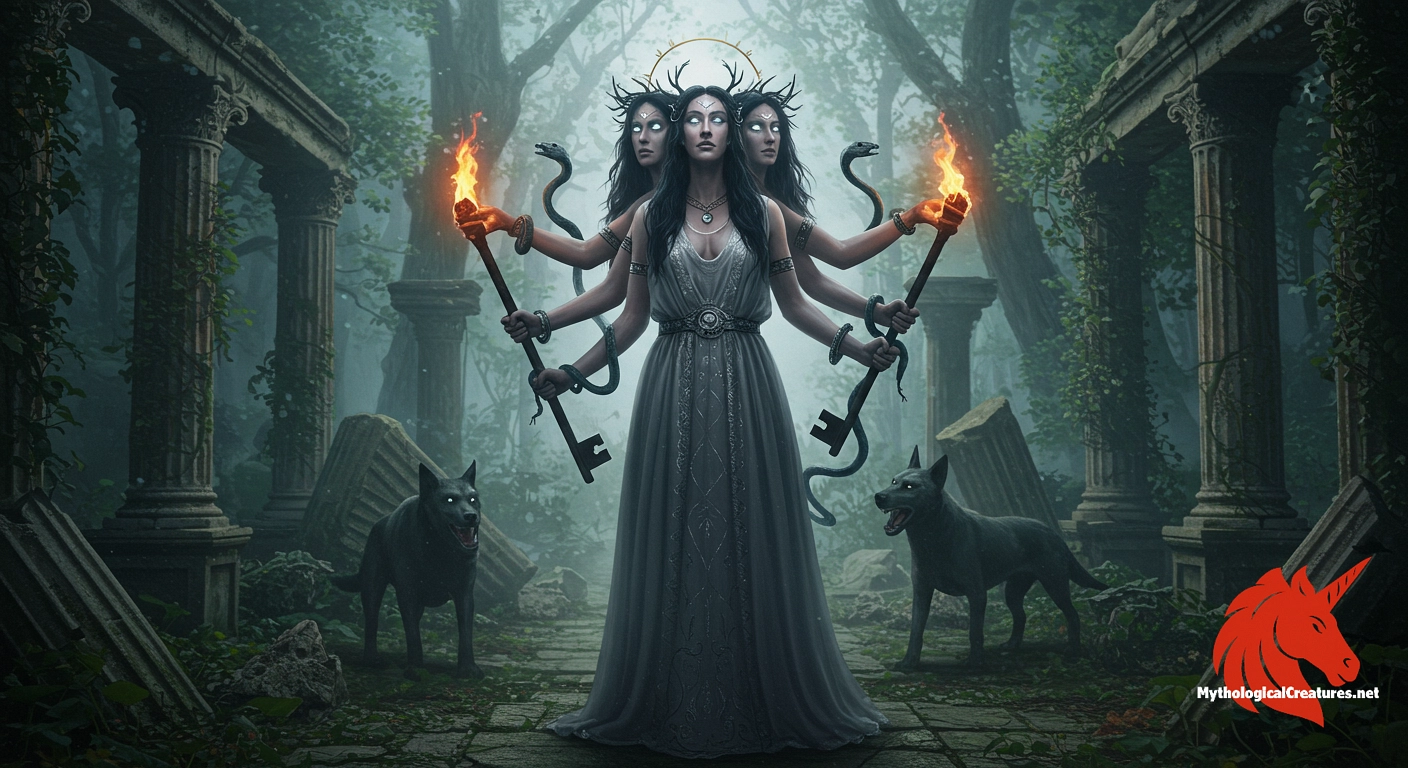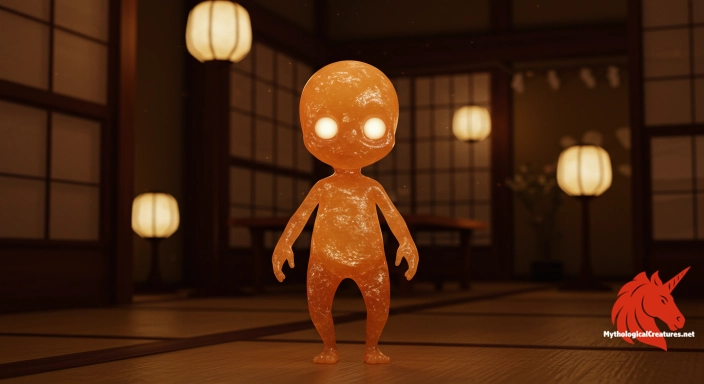Hecate: Hecate is an ancient Greek goddess associated with magic, crossroads, night, and the Moon.

Hecate
Hecate - Hecate played a crucial role in ancient religion, bridging the mortal and divine through her associations with magic, liminality, and cosmic order.
Origins & First Encounters
Hecate emerges as a complex and enigmatic goddess within ancient Greek religion, her identity woven through layers of myth and magic. Born from the early tapestry of divine narratives in the 8th century BCE, she first appears in Hesiod’s Theogony, where her significance is unmistakable. Her dominion spans the mysterious realms of night, crossroads, magic, and the celestial, marking her as a guardian of liminal spaces. The goddess is distinguished by her association with both light and darkness, inviting worship that celebrated her dualities. Communities such as the witches of Thessaly revered her for her protective qualities and her potent magical influence. Her ambiguous character allowed her to bridge the domains of earth, sky, and sea, reflecting a harmony between the natural and the supernatural. Over time, her multifaceted nature granted her a unique position that defied simple classification within the Greek pantheon. This enduring presence has cemented her role as a timeless symbol of transformation, mystery, and protective power.
Source Texts & Tale Variants
Ancient literature provides us with the earliest glimpses of Hecate’s character, notably in Hesiod’s Theogony, where she is portrayed with reverence and authority. Diverse literary traditions expanded her image, gradually introducing layers that would later merge in her triple-formed representations. Various poetic and ritual texts from the classical period contributed additional details, enriching her portrayal as both a guardian of sacred thresholds and a mystical guide of souls. The deity is mentioned with nuanced differences in both early Greek writings and later Hellenistic compositions, revealing her evolving cultic significance. In the Roman era, she was often conflated with Diana and Artemis under the epithet Trivia, which underscored her link to crossroads and protection. Esoteric sources, such as the Chaldean Oracles, further intertwined her with cosmic themes and universal salvation. Localised folklore in regions like Thessaly and Asia Minor offers distinct variants that emphasise her connection with magic and night. These overlapping sources paint a picture of a goddess whose myth was continuously reshaped across cultural and temporal landscapes.
Form & Powers
Hecate is typically depicted with a striking set of symbols that set her apart from other deities in the classical pantheon. In many artistic representations, she is shown holding a pair of torches, which serve as beacons guiding worshippers through darkness. Her iconography frequently includes a prominent key, emblematic of her ability to unlock the mysteries of the underworld and other hidden realms. Artists have also portrayed her with serpents, an image that conveys ideas of regeneration, transformation, and eternal life. Accompanying these symbols are often images of dogs, which reinforce her role as a sentinel at the gateways between worlds. In later periods, her portrayal evolved into a triple-formed figure, with three distinct bodies or faces representing her sovereignty over the earth, sea, and sky. Variations in her physical depiction reflect local artistic traditions, with some statues and vase paintings emphasising a more austere, formidable presence. Each element of her attire and demeanour is purposefully chosen to signal both her protective nature and her connection to the liminal and mystical aspects of the cosmos. Together, these attributes create an unforgettable visage that balances both austerity and allure.
Regional Faces
Regional interpretations of Hecate underscore the adaptability of her cult as it spread across the ancient Mediterranean. In Asia Minor, particularly among the Carians of Lagina, she was venerated with ceremonies that highlighted her protective and esoteric attributes. The Sicilian sanctuary at Selinunte further underscores her localised worship, where rituals centred on her role as a guardian of thresholds were intricately developed. In Thessaly, popular cult practices embraced her as a patroness of magic and the nocturnal, reflecting a more earthy and populist connection. Urban centres like Athens incorporated her into a broader domestic cult, where she was invoked as a protector of the household along with other key deities. The Roman adaptation, which identified her with the goddess Trivia, tailored her image to the needs of travellers and those at crossroads. Each regional variant honed in on particular aspects of her power and mystery, resulting in a rich tapestry of iconography and ritual practices. These adaptations illustrate how local beliefs and societal needs played a crucial role in shaping her divine persona. The resulting regional mosaic highlights both the universality and the particularity of her mythic character.
Cultural Parallels
Hecate’s intricate qualities invite comparison with other deities who occupy similar spaces on the mythological spectrum. Her guardianship of crossroads and liminal thresholds finds resonance with figures such as Artemis and Diana, who similarly balance dualities of nurture and the wild. The prominence of her triple form echoes a broader tradition in which deities are represented in triadic forms to symbolise multifaceted power. Comparable figures in Celtic mythology and other Indo-European traditions also embody the qualities of transition, transformation, and the mysterious boundary between life and death. The integration of chthonic, protective, and magical elements in her narrative allows for parallels with the Egyptian Isis and even the fierce aspects of Hindu Kali. Such comparative analyses reveal a shared cultural fascination with figures who operate on the margins of the known and the unknown. The recurrent themes of rebirth, protection, and metamorphosis bind Hecate to a universal motif found in various mythic traditions. These enduring similarities affirm the idea that diverse cultures have long sought to personify the enigmatic forces that govern change. In drawing these parallels, one observes a common thread that links the mystical roles of different deities across civilizations.
Legacy & Modern Evolution
Over the centuries, the figure of Hecate has undergone a significant transformation, evolving into a symbol of both ancient mysticism and contemporary empowerment. Early portrayals emphasised her role as a liminal deity, whose mysterious presence governed the transitions between worlds. The Roman era brought with it a reshaped image linked to travel and the protection of crossroads, blending her core attributes with those of other deities like Diana. Throughout the medieval period, Hecate was increasingly associated with witchcraft and the hidden realms, often casting her in a shadowy and enigmatic light. Modern interpretations have reimagined her as a beacon of female power and the reclaiming of ancient spiritual practices. Contemporary neopagan movements and artistic communities frequently celebrate her as an emblem of transformation, resistance, and the unfettered exploration of the mystical. Her image has been adapted in literature, film, and visual arts, offering fresh insights while honouring her profound mythological roots. Today, Hecate continues to inspire through her rich symbolism and capacity for crossing boundaries, representing both the challenges and the possibilities of the unknown. This dynamic evolution attests to the enduring relevance of her myth, which transcends time and resonates with modern audiences in unexpected ways.
Interesting Fact
An intriguing aspect of Hecate's iconography is her unique triple-formed depiction, which represents her ability to embody multiple realms and roles simultaneously.
Quick Creature Info
Features:
Associations:
Our Mythic Legendary Rating:

Also Sometimes Known As:
Habitat:
Supernatural Powers:
Physical Attributes:
Abilities:
Behavior:
Lore:
Related Creatures, Tales or Lore
- DDiana
- AArtemis
- TTrivia
References
Discover Another Mythical Legend You May Not Have Heard Of?
Uncover the mysteries of ancient folklore and expand your knowledge of legendary beings from cultures around the world.
Dare to Meet the Abura-akago....
Mythical Disclaimer: The images and data on this site are derived from various historical and literary sources, but we have found that many myths often have multiple versions and interpretations across references, sometimes contradictory. As a result, these creature depictions are artistic interpretations—imaginative blends of folklore, legend, and a dash of AI guesswork. Because creature descriptions vary widely, our illustrations and accompanying information represent our best effort to honor mythology while bridging creative gaps. Enjoy these interpretations—just remember, we've done our best to respect the stories and validate available data, but in the realm of mythology, details often shift, imagination leads the way, and nothing is ever set in stone!
Curated by the Mythological Creatures Team (rev. May 2025)
